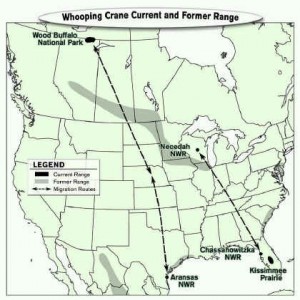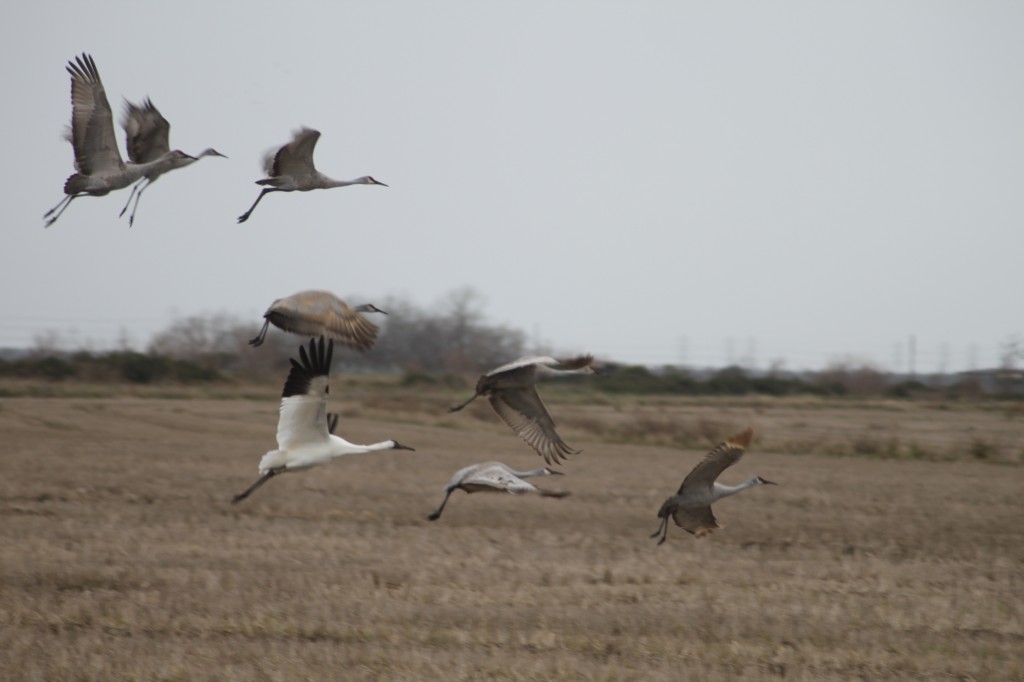by Chester McConnell, Whooping Crane Conservation Association
They are on their way! The whooping cranes have departed from their Wood Buffalo National Park nesting grounds in Canada and are migrating towards Aransas National Wildlife Refuge on the Texas coast. For many thousands of years the endangered cranes have made this annual 2,400 mile migration. It is one of nature’s wonders.
The Whooping Crane Conservation Association has received dozens of reports of whoopers from birders in Alberta and Saskatchewan, Canada and North Dakota, Nebraska and Texas. Approximately 300 whoopers are expected to arrive at Aransas Refuge by late November. Hopefully the thirty-four (34) juvenile cranes that were observed on the Canadian nesting grounds will all make it to Texas with the adult birds.
During the nesting period in May sixty six (66) whooping crane nests were discovered by the Canadian Wildlife Service. Three months later in August, an additional three (3) family groups were identified indicating that there were at least sixty-nine (69) nesting attempts during the 2012 nesting season. In early August, just prior to fledging, thirty-four (34) young including two (2) sets of twins were observed on the breeding grounds. Ten of the young whooping cranes were marked with leg bands and satellite transmitters so details about their migration can be learned.
Whoopers usually follow a migratory path through Saskatchewan, North and South Dakota, Nebraska, Kansas, Oklahoma and Texas. In central Texas they fly near cities such as Wichita Falls, Fort Worth, Waco, Austin, and Victoria. During migration they often pause overnight to use wetlands for roosting and agricultural fields
They nearly migrate in small groups of less than 4 to 6 birds, but they may be seen roosting and feeding with large flocks of the smaller sandhill crane. They are the tallest birds in North America, standing nearly five feet tall. They are solid white in color except for black wing-tips that are visible only in flight. They fly with necks and legs outstretched. Hunters are urged to learn to identify whooping cranes to avoid mistaking them for some other birds.To help identify whooping cranes, please click on the following link: https://whoopingcrane.com/whooper-identification/
Since beginning their slow recovery from a low of 16 birds in the 1940s, whoopers have, with few exceptions, always wintered on the Texas coast on and near Aransas National Wildlife Refuge. However, in the winter of 2011-12, several groups of whooping cranes expanded their wintering areas to include more coastal areas and even some inland sites in Central Texas, Kansas and Nebraska—patterns that surprised crane biologists. Texas has initiated the “Texas Whooper Watch” program that asks the public to help us discover more about where whooping cranes stop in migration and to be ready to learn more about these potential new wintering areas. The Whooping Crane Conservation Association and Texas will share information collected about whoopers from birders to improve our knowledge about the birds.
The Whooping Crane Conservation Association is hopeful for a much better winter season on Aransas Refuge. As most whooping crane interests know, last winter on the refuge was abnormal in several respects, including severe drought conditions and poor food availability. Some of the cranes spent some or all of the winter away from Aransas making accurate counts of the birds impossible. During the past several months, the Aransas area has received more rain and habitat conditions are improved. Blue crab numbers have rebounded along the Aransas Refuge coast and the returning whooping cranes will, at least, start out with a good food supply. Hopefully the wolfberry crop will improve and be another source of food.




Pingback: TAP Urges Attendance at Whooping Crane Count Meeting « Whooping Crane Conservation Association